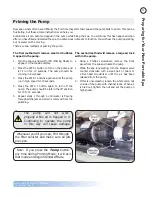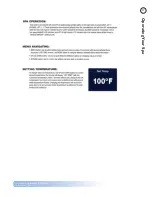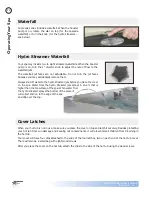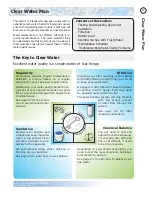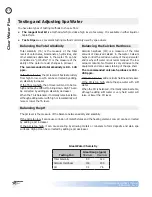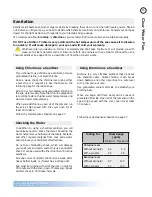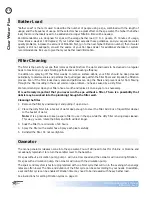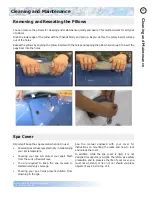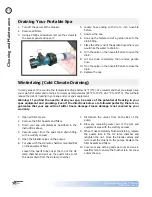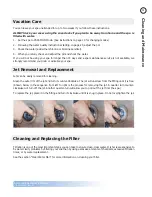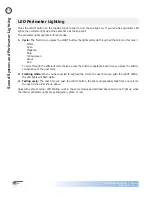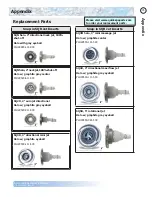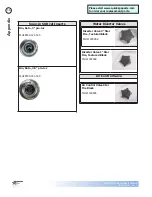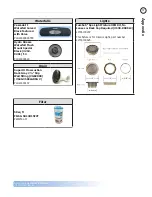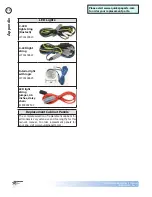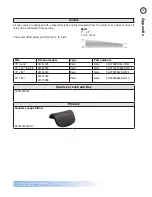
American Spa Owner’s Manual
LTR50001143, Rev. M
Clear
W
ater Plan
24
Testing For:
Ideal Range (ppm)
Minimum
Maximum
Total Alkalinity
80
120
Calcium Hardness
150
200
pH
7.2
7.6
Testing and Adjusting Spa Water
You have two types of testing methods to choose from:
•
The reagent test kit
is a method which provides a high level of accuracy. It is available in either liquid or
tablet form.
•
Test strips
are a convenient testing method commonly used by spa owners.
Balancing the Total Alkalinity
Balancing the Calcium Hardness
Balancing the pH
Ideal Water Chemistry
Total alkalinity (TA) is the measure of the total
levels of carbonates, bicarbonates, hydroxides, and
other alkaline substances in the water. TA can be
considered a “pH buffer”. It is the measure of the
ability of the water to resist changes in pH level.
The recommended total alkalinity is 80 - 120
ppm.
If the TA is too low
, the pH level will fluctuate widely
from high to low. Low TA can be corrected by adding
an alkalinity increaser.
If the TA is too high, the pH level will tend to be too
high and may be difficult to bring down. High TA can
be corrected by adding an alkalinity decreaser.
When the TA is balanced, it normally remains stable,
although adding water with high or low alkalinity will
raise or lower the TA level.
Calcium hardness (CH) is a measure of the total
amount of dissolved calcium in the water. Calcium
helps control the corrosive nature of the spa’s water
and is why soft water is not recommended. The low
calcium content of soft water is very corrosive to the
equipment and can cause staining of the spa shell.
The recommended calcium hardness is 150 -
200 ppm.
If the CH is too low, add a calcium hardness increaser.
If the CH is too high, dilute the spa water with soft
water.
When the CH is balanced, it normally remains stable,
although adding soft water or very hard water will
raise or lower the CH level.
The pH level is the measure of the balance between acidity and alkalinity.
If the pH is too low
, it can cause corrosion of metal fixtures and the heating element. Low pH can be corrected
by adding a pH increaser.
If the pH is too high, it can cause scaling by allowing metals or minerals to form deposits and stain spa
surfaces. High pH can be corrected by adding a pH decreaser.
Summary of Contents for AM-418B
Page 1: ...LTR50001143 Rev M 1 1 17...
Page 19: ...American Spa Owner s Manual LTR50001143 Rev M Operating Your Spa 17...
Page 20: ...American Spa Owner s Manual LTR50001143 Rev M Operating Your Spa 18 F F F F A...
Page 21: ...American Spa Owner s Manual LTR50001143 Rev M Operating Your Spa 19 Settings Screens...
Page 22: ...American Spa Owner s Manual LTR50001143 Rev M Operating Your Spa 20 Error Screens...
Page 47: ...American Spa Owner s Manual LTR50001143 Rev M Appendix 45...
Page 48: ...American Spa Owner s Manual LTR50001143 Rev M Appendix 46...
Page 49: ...American Spa Owner s Manual LTR50001143 Rev M Appendix 47...
Page 50: ...American Spa Owner s Manual LTR50001143 Rev M Appendix 48...
Page 51: ...American Spa Owner s Manual LTR50001143 Rev M Appendix 49...


